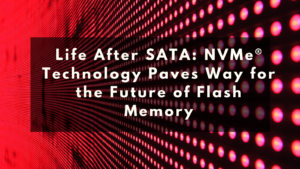
Life After SATA: NVMe® Technology Paves Way for the Future of Flash Memory
BlogBy Ilya Cherkasov, Data Center NVMe SSD Product Manager, KIOXIA America, Inc.
Today’s data-centric storage and computing tasks have led to a significant demand for higher data read and write performance, as well as increased reliability. When end-users are tasked with choosing the right SSD for their server, one of the main considerations is the SSD interface. The most common SSD types are based on SATA (Serial Advanced Technology Attachment), SAS (Serial Attached SCSI) and NVM Express® (Non-Volatile Memory express) protocols. Adoption of SATA is rapidly declining as it is replaced by NVMe® protocol, which has been specifically designed for modern and future non-volatile memory storage devices. In this blog, I’ll discuss the history of SATA and the demand for NVMe technology, as well as SATA and NVMe SSD performance comparisons.
A Brief History of SATA
The original ATA (Advanced Technology Attachment) was a simplified consumer-oriented industry standard for the inclusion of hard disks. In 2000, SATA was announced to provide several advantages over this earlier interface, including reduced cost and faster data transfers. With the emergence of flash-based SSDs, SATA became a standard protocol and soon replaced direct HDD.
Despite some application performance delays, SATA became the most common and cost-effective interface for SSDs. However, the last major SATA revision (SATA 3.0) was ratified in 2009, and there have been no major performance improvements or future enhancements planned since. Since SATA 3.0 was ratified many years ago, CPU and NAND flash memory technology has advanced by leaps and bounds, and the SATA interface has become a bottleneck.
SATA Limitations
SATA architecture has led to bottleneck issues for many applications. When deployed in a server, SATA SSD I/O commands must travel through multiple layers, preventing the ability to take complete advantage of the flash-based media. In addition, with the SATA interface being a half-duplex, it uses one lane at a time for transferring data, making it incredibly easy for this single lane to become a bottleneck.
As servers evolve with more powerful, multicore processors, they have an abundance of RAM waiting for data transactions to be complete. With the SATA bottleneck, this results in an underutilization of compute resources, wasting the performance capabilities of modern CPUs and of the flash memory in the SSD.
The Rise of NVMe Technology – Enterprise and Data Center SSDs
As the industry witnessed the limitations of the SATA protocol, technologists joined forces to design what we know today as the NVMe interface. While SATA was initially designed for consumer-grade HDDs, NVMe architecture was specifically designed for flash-based SSD implementations. NVMe SSDs are a game changer, as they can connect directly to server CPUs through the PCI Express® (PCIe®) interface bus, thus bypassing the host bus adapters (HBAs) that SAS and SATA drives require. We saw the first NVMe products focus on ultra-high performance and enterprise feature sets. These were designed for bleeding edge applications, which we typically refer to as enterprise class.
Following enterprise class NVMe SSDs, data center NVMe SSDs are optimized for server attached applications. These SSDs connect to a server through the PCIe interface bus where each PCIe lane is full duplex and can move data bi-directionally. Data center NVMe SSDs offer a more cost-effective design compared to enterprise class NVMe SSDs, while delivering significantly higher performance, larger capacities and more capabilities than SATA SSDs. Many vendors have produced data center NVMe SSDs and KIOXIA was among the first to introduce data center NVMe SSDs with its CD and XD Series drives.
SATA vs. NVMe SSD Performance Comparison
When compared to enterprise SATA, data center NVMe SSDs are better equipped to handle demanding storage workloads at faster rates and deliver data more efficiently. Data center NVMe SSDs are built for speed and quality of service (QoS), which results in better server utilization and therefore better Total Cost of Ownership (TCO).
Source: KIOXIA, Data Center NVMe™ SSDs: A New Category of SSD and Why You Need It
Taking full advantage of the PCIe 4.0 interface, NVMe SSDs utilizing 4 lanes (x4) allow up to 64GT/s (63Gb/s after encoding). This is over 10x faster than the SATA 3.0 interface. In our KIOXIA lab, performance tests (recorded above) discovered that data center NVMe SSDs delivered 5.45x more read bandwidth than SATA, as well as 3.27x more write bandwidth, 5.88x more random read IOPS and 1.43x more random write IOPS.
Along with these noteworthy performance advantages, SATA-based SSDs typically do not exceed 7,680GB capacity point, whereas data center NVMe SSDs offer capacity points up to 15,360GB today, with 30,720GB on the horizon.
Life after SATA
While SATA was great for getting SSDs adopted in the data center, data center PCIe 4.0 NVMe SSDs deliver significantly higher performance, lower latency and relieve the bottleneck between the CPU and flash storage. As future generations of performance driven applications require organizations to rethink their enterprise and data center strategies, SATA will become a thing of the past.
Life after SATA looks promising, with IDC predicting data center NVMe SSD adoption will grow to 91% by the end of 2023. In addition, the industry can look forward to seeing future innovations such as tri-mode HBA / RAID controllers and U.3 universal backplanes, which we envision will further enable NVMe SSDs to become the leading storage interface of the future.
To learn more about SATA and NVMe SSD performance metrics and market predictions, I invite you to view KIOXIA’s suite of presentations. For more insights from NVM Express members, I encourage you to check out additional NVM Express blogs.
